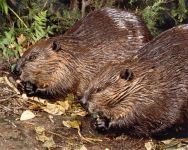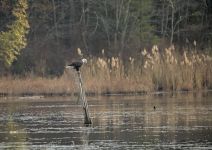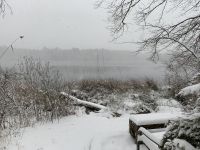Beaver Tales from Unexpected Wildlife Refuge, February 2022
Bald eagle on main pond
Snow-covered main pond
It's been an active winter thus far, with three snowstorms in the past two months. At Unexpected, nesting among the thick stands of trees, bald eagles are preparing for their hatchlings. In the months leading up to winter, eagles build or refurbish their nests, which can be 4 to 5 feet in diameter and 2 to 4 feet deep. Constructed of sticks and grass and lined with moss and downy feathers from the parents, the nest provides warmth and shelter for the family. Eagles are among the first birds to build nests and lay their eggs with the hatchlings expected in late February and early March. If a nest site has been successful for the bonded pair, they will return year after year.
Beaver Tales – including our pop-up Kids' corner section – will highlight some of the wonderful bird species residing on the Refuge.
manager@unexpectedwildliferefuge.org to schedule.
Running a wildlife refuge is not only physically and emotionally demanding, there are always expenses with which to deal. Although we are frugal in how we spend Refuge funds – having only one employee and an all-volunteer Council of Trustees – we need your help in ensuring the continuation and longevity of the Refuge. We hope you will take the time to make the most generous donation you can...now . Please know that we – and the wildlife – are grateful for your continued support.
Contents of this month's newsletter:
Beavers in the news
Here are some recent news media articles concerning beavers. You can see our entire and growing list, a tribute to this wonderful keystone species, in our Beavers in the News page . If you come across a news item on beavers, please send us the link so that we can consider it for inclusion.
Beavers support freshwater conservation and ecosystem stability , Research Brief, University of Minnesota Duluth.
Beaver lodge
One of the most comprehensive studies conducted on beavers has conclusively demonstrated that beavers are essential for freshwater conservation and ecosystem stability by creating and preserving aquatic and wetland environments in Minnesota.
Major new study shows role beavers could play in restoring Scotland's rivers , by University of Aberdeen.
Beaver
Beavers could make an important contribution to improving the condition of Scotland's rivers, including helping to improve water quality and limiting the effects of drought.
Beaver Dams Help Wildfire-Ravaged Ecosystems Recover Long after Flames Subside , by Isobel Whitcomb.
Beaver dams at Dixon Creek in Oregon
Oregon endured the third-largest wildfire in its recorded history last summer.
Snapshots of life at the Refuge
Wood duck male
Male and female wood ducks
Wood duck female
Wood ducks at Wild Goose Blind
American kestrel female
American kestrel female
American kestrel female
American kestrel with a meal
Green heron at Otter Dam
Green heron at Otter Dam
Green heron spotted on trail camera
Canada geese
Canada geese
Groups of geese aren't always gaggles
Hooded mergansers
Hooded mergansers
Hooded merganser sounds like pickerel frog
Eastern towhee
Eastern towhee
Eastern towhee displays at Headquarters
Kids' corner
When children have opportunities to observe wildlife, a whole new world of wonder can open up. Let's see what it's like to observe the wildlife at UWR from a kid's perspective.
Robin with worm
Robins by Sylvia Cudrak, age 8
Take action to help wildlife at the Refuge
Woodcock
Simple ways to help the Refuge
Catbird
Your unwanted vehicle, another way to help the Refuge CARS vehicle donation program . CARS will accept any vehicle, running or non-running, and offer free towing throughout the United States. Once they have processed and sold the vehicle, they will donate a majority of the proceeds directly to the Refuge.
https://careasy.org/nonprofit/unexpected-wildlife-refuge to participate. Not only does this provide an easy way to be rid of an unwanted vehicle, you will also be helping wildlife at the same time.
Take action to help wildlife everywhere
Here are a few of the current issues where animals, whether living freely or imprisoned in circuses, zoos or other venues, can benefit from your help. We urge you to take action and share with others.
Snowy egret
Urge Congress to Support the Migratory Bird Protection Act Please urge your U.S. Representative to strengthen protections for birds by supporting the Migratory Bird Protection Act. Strengthen protections for birds by supporting the Migratory Bird Protection Act.
Rufous hummingbird
Birds Tell Us That We Need To Act On Climate Call on elected leaders to create a brighter future for birds through durable and inclusive policies and climate solutions.
Contact us
Unexpected Wildlife Refuge
http://unexpectedwildliferefuge.org/
info@unexpectedwildliferefuge.org








